Logic Supply ML100G-50 Fanless Skylake vPro Industrial NUC Review
by Ganesh T S on February 27, 2017 8:00 AM ESTPerformance Metrics - I
The Logic Supply ML100G-50 was evaluated using our standard test suite for low power desktops / industrial PCs. Not all benchmarks were processed on all the machines due to updates in our testing procedures. Therefore, the list of PCs in each graph might not be the same. In the first section, we will be looking at SYSmark 2014 SE, as well as some of the Futuremark benchmarks.
BAPCo SYSmark 2014 SE
BAPCo's SYSmark 2014 SE is an application-based benchmark that uses real-world applications to replay usage patterns of business users in the areas of office productivity, media creation and data/financial analysis. In addition, it also addresses the responsiveness aspect which deals with user experience as related to application and file launches, multi-tasking etc. Scores are meant to be compared against a reference desktop (the SYSmark 2014 SE calibration system in the graphs below). While the SYSmark 2014 benchmark used a Haswell-based desktop configuration, the SYSmark 2014 SE makes the move to a Lenovo ThinkCenter M800 (Intel Core i3-6100, 4GB RAM and a 256GB SATA SSD). The calibration system scores 1000 in each of the scenarios. A score of, say, 2000, would imply that the system under test is twice as fast as the reference system. Since the Logic Supply ML100G-50 is one of the first passively cooled PCs to be subject to the SYSmark 2014 SE benchmark, we only have the reference system to compare against in this subsection.

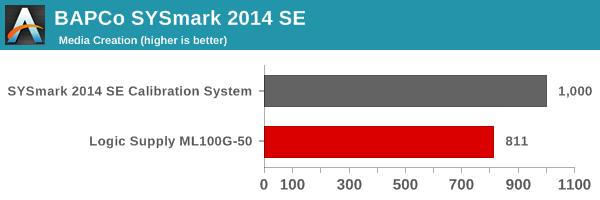

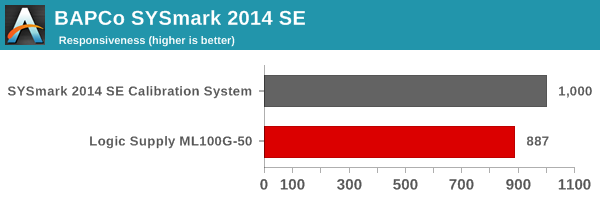

SYSmark 2014 SE also adds energy measurement to the mix. A high score in the SYSmark benchmarks might be nice to have, but, potential customers also need to determine the balance between power consumption and the efficiency of the system. For example, in the average office scenario, it might not be worth purchasing a noisy and power-hungry PC just because it ends up with a 2000 score in the SYSmark 2014 SE benchmarks. In order to provide a balanced perspective, SYSmark 2014 SE also allows vendors and decision makers to track the energy consumption during each workload. In the graphs below, we find the total energy consumed by the PC under test for a single iteration of each SYSmark 2014 SE workload and how it compares against the calibration systems.
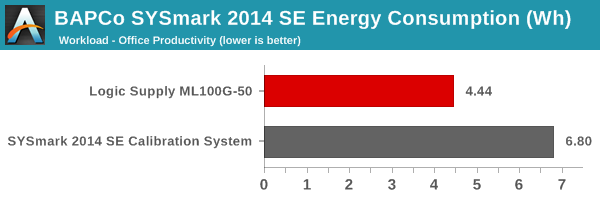


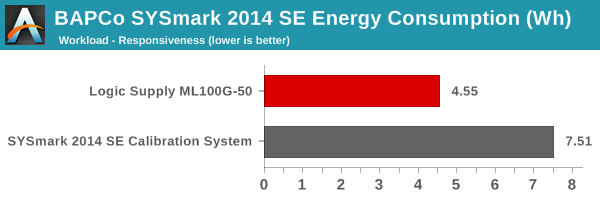
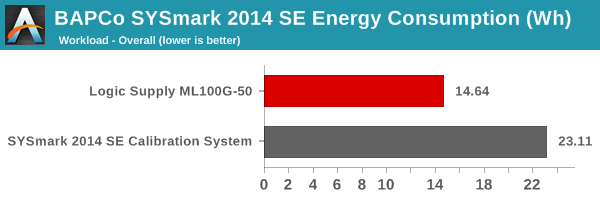
The U-series Core i5-6300U is not going to be competitive against a full-blown 65W TDP desktop processor, but, in terms of energy consumption, the ML100G-50 is a lot better compared to the reference desktop.
Futuremark PCMark 8
PCMark 8 provides various usage scenarios (home, creative and work) and offers ways to benchmark both baseline (CPU-only) as well as OpenCL accelerated (CPU + GPU) performance. We benchmarked select PCs for the OpenCL accelerated performance in all three usage scenarios. These scores are heavily influenced by the CPU in the system. The Core i5-6300U enables the ML100G-50 to come out on top in all of the Futuremark benchmarks when compared with fanless systems evaluated earlier using the same methodology. The closest competitor is the Zotac ZBOX CI523 nano based on a Core i3-6100U.



Miscellaneous Futuremark Benchmarks





The Intel HD Graphics 520 is also one of the most powerful GPUs we have seen in fanless computing systems in this form factor, as shown by the 3DMark benchmarks in the above graphs.
3D Rendering - CINEBENCH R15
We have moved on from R11.5 to R15 for 3D rendering evaluation. CINEBENCH R15 provides three benchmark modes - OpenGL, single threaded and multi-threaded. Evaluation of select PCs in all three modes provided us the following results.



In the single-threaded version, the ML100G-50 performs similar to the ML100G-30 despite the 100 MHz bump in the core clock. However, the multi-threaded version gives it a clear lead. In the OpenGL version, the Zotac ZBOX CI53 nano using the Core i3-6100U with the same graphics configuration (HD Graphics 520 operating at 300 MHz / 1 GHz) has a slight lead.










37 Comments
View All Comments
DarekLogic - Tuesday, February 28, 2017 - link
Here's that ML100G-10 link without the errant parenthesis: https://www.logicsupply.com/ml100g-10BrokenCrayons - Monday, February 27, 2017 - link
Logic Supply sells the DA-1000 which has two Intel ethernet adapters and is passively cooled. Though it's CPU is based on the Bay Trail Atom, for a pfSense router project, it's probably sufficiently powerful AND would likely be a bit more efficient than a Skylake-based system.Shadowmaster625 - Monday, February 27, 2017 - link
That huge white block is a thermal pad?DarekLogic - Monday, February 27, 2017 - link
Darek here from Logic Supply. That's correct, that's a thermal pad for the SSD. As silly as it may look, in our testing it resulted in a roughly 6-12°C drop in SSD temperature depending on what the system is doing.Thanks for the question.
BrokenCrayons - Monday, February 27, 2017 - link
I haven't ordered anything from Logic Supply in a few years, but I have done business with the company a few times for small orders. They were easy to deal with and I'd happily vouch for them putting together good fanless systems.Ranger1065 - Tuesday, February 28, 2017 - link
Yawn.Valantar - Tuesday, February 28, 2017 - link
As usual for these UCFF reviews, I (sorely!) miss pictures of the actual cooling solution. I get that you don't want to disassemble it before testing (having to replace thermal paste and so on), but can't you at least do it afterwards? Does it take more than removing the four screws in the motherboard? I'm very interested in seeing the actual implementation of the passive cooling solution here.Valantar - Tuesday, February 28, 2017 - link
As usual for these UCFF reviews, I (sorely!) miss pictures of the actual cooling solution. I get that you don't want to disassemble it before testing (having to replace thermal paste and so on), but can't you at least do it afterwards? Does it take more than removing the four screws in the motherboard? I'm very interested in seeing the actual implementation of the passive cooling solution here.Spartacus00 - Tuesday, February 28, 2017 - link
Would love to see comparisons to additional manufacturers. We have used Tangent for their Rugged Mini PC's and had great success. They were able to send us a demo unit, which Logic Supply was not; and were very flexible with the types of configurations we wanted in the machines. Worth looking into for anyone who is shopping for industrial fanless.fanofanand - Wednesday, March 1, 2017 - link
I still can't wrap my head around a $450 PC selling for $1150 because it's small. I get it, I understand all the reasons why, it still just doesn't make sense to me for 99.9999999% of consumers. Nobody has an extra 5 liters of space ANYWHERE around their desk?